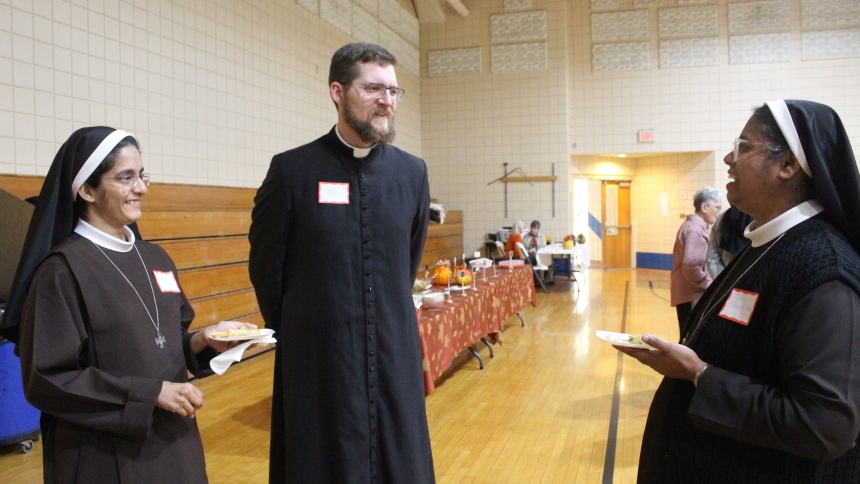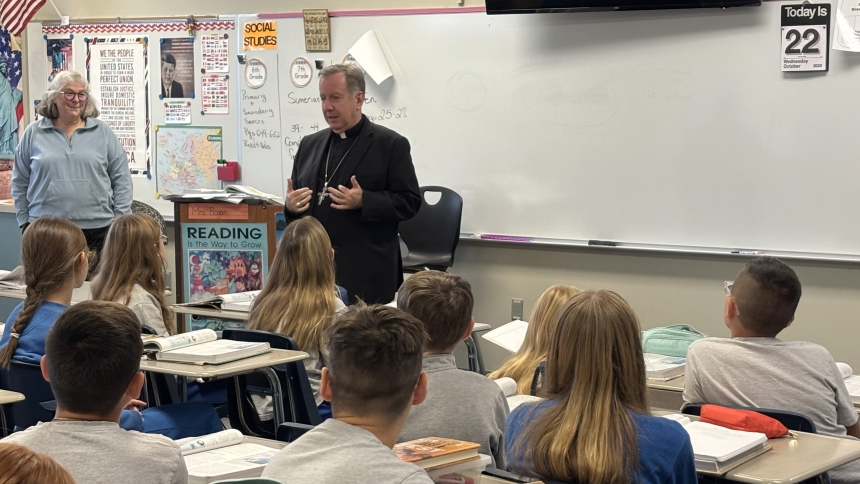
(OSV News) – The December reopening of Notre Dame Cathedral in Paris after a devastating 2019 fire marked "a beautiful symmetry" with a similar project underway in a U.S. diocese, a bishop told OSV News.
"It gives us great hope," said Bishop Donald J. Hying of Madison, Wisconsin.
In 2005, the Madison Diocese's historic St. Raphael Cathedral was destroyed in a fire set by William Connell, a local man who had started the blaze after breaking into the church and stealing a bottle of wine. Connell, who was homeless, surrendered to police the following day. He said he was delusional at the time from not taking his antipsychotic medication. Connell agreed to a plea deal that saw him sentenced in 2007 to 15 years in prison followed by 15 years of extended supervision upon his release.
Then-Bishop Robert C. Morlino and Msgr. (later Bishop) Paul Swain, the cathedral rector, visited Connell in 2006 and extended their forgiveness. Bishop Morlino later noted that Connell had expressed genuine sorrow and "his hope that the cathedral will be rebuilt."
What followed was two decades without a diocesan cathedral, with the ruined site of St. Raphael's refashioned as a prayer garden.
Bishop Hying told OSV News that since his 2019 installation, which followed the 2018 death of Bishop Morlino, he has relied on a portable cathedra. A cathedra is the bishop's throne, an architectural element of a cathedral signifying the gravity of the bishop's office. The portable cathedra has accompanied Bishop Hying to various parishes for ordinations and the annual chrism Mass, at which the bishop blesses oils for sacramental use in his diocese.
But as the Madison Diocese carried on its mission minus a mother church, a foundation of living stones – a reference to 1 Pt 2:5 – was being laid, said Bishop Hying.
"Bishop Morlino prioritized the building of the new campus ministry center at University of Wisconsin-Madison," said Bishop Hying, referencing the St. Paul's Catholic Student Center. The fruit of that is extraordinary. He said this past Easter, 75 college students at UW-Madison became Catholic. "This year there's over a hundred in formation to do the same next Easter."
The diocese also launched a multimillion dollar campaign, yielding $44 million in pledges to fund the cost of forming seminarians. Bishop Hying said his predecessor saw those initiatives as a "greater priority at the moment, in terms of evangelization, especially of (forming) priests and young people."
Still, the need and desire for a cathedral grew – and so too did other challenges, including ones that led to a restructuring of the diocese as part of a program called "Into the Deep," said Bishop Hying.
As a result, rather than building a new cathedral from the ground up, the decision was made to petition the Vatican for the approval to elevate an existing parish church as the cathedral.
St. Bernard in Madison was proposed, and in January, the diocese received permission from the Vatican to proceed. In September, Bishop Hying celebrated a Mass formally designating the parish church as the diocese's new cathedral.
Parishioners were elated – and they'd unknowingly gotten a head start, said Bishop Hying.
"The response was one of great enthusiasm and gratitude," he said, noting St. Bernard parishioners had already launched a project for a new organ. "And then the whole idea of (St. Bernard) becoming the cathedral came along, so that they really saw it as an affirmation of the beauty of the church, of the importance of the parish and their own role in living up a faith in the city. So they were very, very happy."
At the same time, transforming St. Bernard – a church built in 1927 – into a fitting cathedral has been hard work, said Bishop Hying.
"Any time you open an old building, you're going to discover things that need to be replaced or fixed that you didn't anticipate," he said. "The poured cement floor that we were thinking would be adequate, turned out to be very inadequate. So the floor had to be taken out and repoured."
In addition, he said, the parking lot needed some "600 truckloads of gravel to fill in a lot of sinkholes," since "things ... had not been done properly 70 or 80 years ago."
Obtaining all the necessary construction permits and coordinating the various aspects of the work has made for "an extraordinary effort," said the bishop. He noted that while the work is in progress, parishioners are celebrating Mass in the gymnasium of the parish school.
Unlike French President Emmanuel Macron, who boldly promised to rebuild Notre Dame in five years, Bishop Hying said there's no "hard and fast date yet" for the formal consecration of St. Bernard as the Madison Diocese's cathedral.
"Our hope is that it would be at Christmastime next year," he said. "But there are a lot of convergent aspects of this that have to come together."
The bishop is also delighted by the patron saint of the new cathedral – St. Bernard of Clairvaux, a 12th-century Cistercian abbot and mystic who profoundly influenced the Catholic Church in medieval Europe.
"St. Bernard was certainly a luminous presence in the church of his age. And certainly his devotion to the Blessed Mother, his scriptural writings, and really his focus on the primacy of charity in the spiritual life, I would see as really things that are illuminative for us today," said Bishop Hying. "My episcopal motto is, 'Love never fails,' from 1 Cor 13. And St. Bernard writes a lot about what it means to love God and others, and then he certainly fuses that into a tremendous devotion to the Blessed Mother."
And to top off the parallel with the Notre Dame reopening, said the bishop, "St. Bernard was a French saint."
- - -
To learn more about the Diocese of Madison's cathedral project, visit MadisonCathedral.org.



